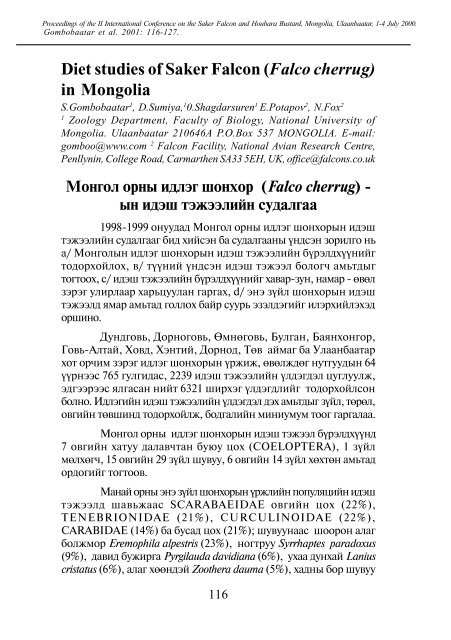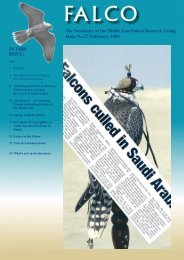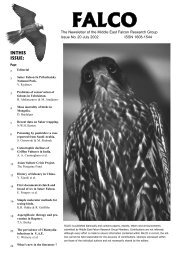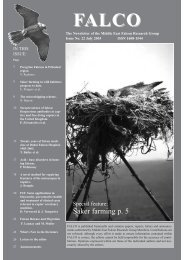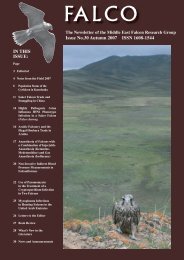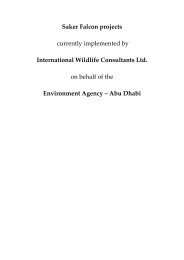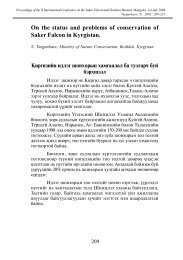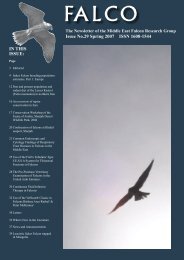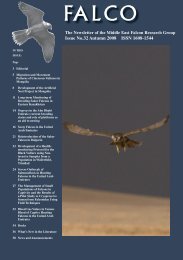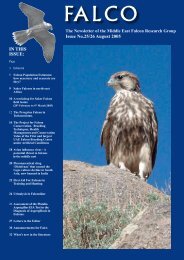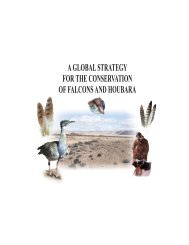Diet studies of Saker Falcon (Falco cherrug) in Mongolia
Diet studies of Saker Falcon (Falco cherrug) in Mongolia
Diet studies of Saker Falcon (Falco cherrug) in Mongolia
Create successful ePaper yourself
Turn your PDF publications into a flip-book with our unique Google optimized e-Paper software.
Proceed<strong>in</strong>gs <strong>of</strong> the II International Conference on the <strong>Saker</strong> <strong><strong>Falco</strong>n</strong> and Houbara Bustard, <strong>Mongolia</strong>, Ulaanbaatar, 1-4 July 2000.Gombobaatar et al. 2001: 116-127.<strong>Diet</strong> <strong>studies</strong> <strong>of</strong> <strong>Saker</strong> <strong><strong>Falco</strong>n</strong> (<strong>Falco</strong> <strong>cherrug</strong>)<strong>in</strong> <strong>Mongolia</strong>S.Gombobaatar 1 , D.Sumiya, 1 0.Shagdarsuren 1 E.Potapov 2 , N.Fox 21Zoology Department, Faculty <strong>of</strong> Biology, National University <strong>of</strong><strong>Mongolia</strong>. Ulaanbaatar 210646A P.O.Box 537 MONGOLIA. E-mail:gomboo@www.com 2 <strong><strong>Falco</strong>n</strong> Facility, National Avian Research Centre,Penllyn<strong>in</strong>, College Road, Carmarthen SA33 5EH, UK, <strong>of</strong>fice@falcons.co.ukÌîíãîë îðíû èäëýã øîíõîð (<strong>Falco</strong> <strong>cherrug</strong>) -ûí èäýø òýæýýëèéí ñóäàëãàà1998-1999 îíóóäàä Ìîíãîë îðíû èäëýã øîíõîðûí èäýøòýæýýëèéí ñóäàëãààã áèä õèéñýí áà ñóäàëãààíû ¿íäñýí çîðè ëãî íüà/ Ìîíãîëûí èäëýã øîíõîðûí èäýø òýæýýëèéí á¿ðýëäõ¿¿íèéãòîäîðõîéëîõ, â/ ò¿¿íèé ¿íäñýí èäýø òýæýýë áîëîã÷ àìüòäûãòîãòîîõ, ñ/ èäýø òýæýýëèéí á¿ðýëäõ¿¿íèéã õàâàð-çóí, íàìàð - ºâºëçýðýã óëèðëààð õàðüöóóëàí ãàðãàõ, d/ ýíý ç¿éë øîíõîðûí èäýøòýæýýëä ÿìàð àìüòàä ãîëëîõ áàéð ñóóðü ýçýëäýãèéã èëýðõèé ëýõýäîðøèíî.Äóíäãîâü, Äîðíîãîâü, ªìíºãîâü, Áóëãàí, Áàÿíõîíãîð,Ãîâü-Àëòàé, Õîâä, Õýíòèé, Äîðíîä, Òºâ àéìàã áà Óëààíáààòàðõîò îð÷èì çýðýã èäëýã øîíõîðûí ¿ðæèæ, ºâºëæäºã íóòãóóäûí 64¿¿ðíýýñ 765 ãóëãèäàñ, 2239 èäýø òýæýýëèéí ¿ëäýãäýë öóãëóóëæ,ýäãýýðýýñ ÿëãàñàí íèéò 6321 øèðõýã ¿ëäýãäëèéã òîäîðõîéëñîíáîëíî. Èäëýãèéí èäýø òýæýýëèéí ¿ëäýãäýë äýõ àìüòäûã ç¿éë, òºðºë,îâãèéí òºâøèíä òîäîðõîéëæ, áîäãàëèéí ìèíèóìóì òîîã ãàðãà ëàà.Ìîíãîë îðíû èäëýã øîíõîðûí èäýø òýæýýë á¿ðýëäõ¿¿íä7 îâãèéí õàòóó äàëàâ÷òàí áóþó öîõ (COELOPTERA), 1 ç¿éëìºëõºã÷, 15 îâãèéí 29 ç¿éë øóâóó, 6 îâãèéí 14 ç¿éë õºõòºí àìüòàäîðäîãèéã òîãòîîâ.Ìàíàé îðíû ýíý ç¿éë øîíõîðûí ¿ðæëèéí ïîïóëÿöèéí èäýøòýæýýëä øàâüæààñ SCARABAEIDAE îâãèéí öîõ (22%),TENEBRIONIDAE (21%), CURCULINOIDAE (22%),CARABIDAE (14%) áà áóñàä öîõ (21%); øóâóóíààñ øîîðîí àëàãáîëæìîð Eremophila alpestris (23%), íîãòðóó Syrrhaptes paradoxus(9%), äàâèä áóæèðãà Pyrgilauda davidiana (6%), óõàà äóíõàé Laniuscristatus (6%), àëàã õººíäýé Zoothera dauma (5%), õàäíû áîð øóâóó116
Proceed<strong>in</strong>gs <strong>of</strong> the II International Conference on the <strong>Saker</strong> <strong><strong>Falco</strong>n</strong> and Houbara Bustard, <strong>Mongolia</strong>, Ulaanbaatar, 1-4 July 2000.Gombobaatar et al. 2001: 116-127.Petronia petronia (2%), ìîíãîë áîëæìîð Melanocorypha mongolica(1%) áà áóñàä (38%); õºõòíººñ ¿ëèéí öàãààí îãîòíî Microtus brandtii(72%), øàð ÷è÷¿¿ë Meriones meridianus (9%), ìîíãîë òàðâàãàMarmota sibirica (6%), ìîíãîë ÷è÷¿¿ë Meriones unguiculatus (5%),ìîíãîë îãîòíî Microtus mongolicus (4%) áà áóñàä õºõòºí (4%) òóñòóñ ýçëýæ áàéíà.1998-1999 îíû ìàíàé îðíû èäëýãèéí íàìàð-ºâëèéí èäýøòýæýýëèéí á¿ðýëäõ¿¿íä øîîðîí àëàã áîëæìîð (Eremophila alpestris),íîãòðóó (Syrrhaptes paradoxus), äàâèä áóæèðãà (Pyrgilaudadavidiana), àëàã õººíäýé (Zoothera dauma), õàäíû áîð øóâóó(Petronia petronia), ìîíãîë áîëæìîð (Melanocorypha mongolica) çýðýãøóâóóä; ¿ëèéí öàãààí îãîòíî, ìîíãîë òàðâàãà, ìîíãîë ÷è÷¿¿ë, øàð÷è÷¿¿ë áà ìoíãîë îãîòíî õºõòºí ãîëëîõ áàéð ñóóðüòàé áàéëà à.Ïèòàíèå ñîêîëà áàëîáàíà(<strong>Falco</strong> <strong>cherrug</strong>) â Ìîíãîëèè 1998-99 ãîäàõ ìû èñëåäîâàëè ïèòàíèå ñîêîëà áàëîáàíàâ Ìîíãîëèè. Öåëüþ èññëåäîâàíèÿ áûëî: îïèñàòü ïèòàíèå ñîêî ëàáàëîáàíà â Ìîíãîëèè, îïðåäåëèòü íàèáîëåå âàæíûå âèäû â ïè òàíèèñîêîëà, ñðàâíèòü ïèòàíèå ñîêîëà ïî ñåçîíàì, è îïðåäåëèòü í àèáîëååâàæíûå îáúåêòû ïèòàíèÿ ïî áèîìàññå.  òå÷åíèå óêàçàííûõ ïîëåâûõñåçîíîâ ìû ñîáèðàëè ïîãàäêè è îñòàòêè äîáû÷è èç ãíåçä ñîê îëà âïðîâèíöèÿõ Äóíäãîâü, Äîðíîãîâü, Óìíóãîâü, Áóëãàí, Áàÿíõîí ãîð,Ãîâü-Àëòàé, Õîâä, Õåíòåé, Äîðíîä è Òóâ, à òàêæå â íåêîòîðûõìåñòàõ áëèç Óëààáààòàðà. Ñáîðû âåëèñü â ðåïðîäóêòèâíûé è çèìíèéñåçîíû. îáùåé ñëîæíîñòè 6321 èäåíòèôèöèðóåìûõ îñòàòêîâ áûëîñîáðàíî èç 765 ïîãàäîê è 2239 îñòàòêîâ äîáû÷è ïîäîáðàííûõ ó 64ãíåçä è èç-ïîä çèìíèõ è ëåòíèõ ïðèñàä ñîêîëîâ. Ìû ðåãèñòðèð îâàëèìèíèìàëüíîå êîëè÷åñòâî æåðòâ è îïðåäåëÿëè âèäû æåðòâ äîòàêñîíîâ ìèíèìàëüíî âîçìîæíîãî ðàíãà.Ïèòàíèå áàëîáàíà âêëþ÷àåò íàñåêîìûõ (Coleoptera) èç 7ñåìåéñòâ, 1 âèä ðåïòèëèé, 29 âèäîâ ïòèö èç 15 ñåìåéñòâ è 14 âèäîâìëåêîïèòàþùèõ èç 6 ñåìåéñòâ.117
Proceed<strong>in</strong>gs <strong>of</strong> the II International Conference on the <strong>Saker</strong> <strong><strong>Falco</strong>n</strong> and Houbara Bustard, <strong>Mongolia</strong>, Ulaanbaatar, 1-4 July 2000.Gombobaatar et al. 2001: 116-127.Âî âðåìÿ ñåçîíà ðàçìíîæåíèÿ ñëåäóþùèå òàêñîíû áûëèîòìå÷åíû â ïèòàíèè áàëîáàíà: SCARABAEIDAE (22%),TENEBRIONIDAE (21%), CURCULINOIDAE (22%),CARABIDAE (14%); Ðîãàòûé æàâîðîíîê Eremophila alpestris (23%),ñàäæà Syrrhaptes paradoxus (9%’), ñíåæíûé âüþðîê Pyrgilaudàdavidiana (6%), ñåðûé ñîðîêîïóò Lanius cristatus (6%), ïåñòðûéêàìåííûé äðîçä Zoothera dauma (5%), êàìåííûé âîðîáåé Petroniapetronia (2%), ìîíãîëüñêèé æàâîðîíîê Melanocorypha mongolica(1%) è äðóãèå ïòèöû (38%); ïîëåâêà Áðàíäòà Microtus brandtii (72%),ïîëóäåííàÿ ïåñ÷àíêà Meriones meridianus (9%), ñèáèðñêèé ñóðîêMarmota sibirica (6%), ìîíãîëüñêàÿ ïåñ÷àíêà Meriones unguiculatus(5%), ìîíãîëüñêàÿ ïîëåâêà Microtus mongolicus (4%) è äðóãèåìëåêîïèòàþùèå (4%).Îñåíüþ è çèìîé áàëîáàíû ïèòàëèñü ôîíîâûìè âèäàìèòàêèìè êàê ðîãàòûé æàâîðîíîê, ñàäæà, ñíåæíûé âþüðîê, ïåñòðûéêàìåííûé äðîçä, êàìåííûé âîðîáåé, ìîíãîëüñêèé æàâîðîíîê;ïîëåâêà Áðàíäòà, ïîëóäåííàÿ ïåñ÷àíêà, ìîíãîëüñêàÿ ïåñ÷àí êà èìîíãîëüñêàÿ ïîëåâêà.AbstractPellets and prey rema<strong>in</strong>s were collected <strong>in</strong> 1998-99 <strong>in</strong>Dundgobi, Dornogobi, Umnugobi, Bulgan, Bayankhongor, Gobi-Altai, Khovd, Khentii, Dornod, Tuv prov<strong>in</strong>ces and some areas <strong>of</strong>Ulaanbaatar city dur<strong>in</strong>g the breed<strong>in</strong>g and w<strong>in</strong>ter seasons. A total <strong>of</strong>6321 prey items were identified from 765 pellets and 2239 prey rema<strong>in</strong>scollected from 64 nests and also both summer and w<strong>in</strong>ter roost sites.The m<strong>in</strong>imum number <strong>of</strong> <strong>in</strong>dividuals <strong>of</strong> animal species, genera, andfamilies from the pellet and prey rema<strong>in</strong>s <strong>of</strong> <strong>Saker</strong> were recorded.Introduction and methodsThe diet <strong>of</strong> breed<strong>in</strong>g and w<strong>in</strong>ter<strong>in</strong>g saker falcons <strong>in</strong> <strong>Mongolia</strong>is poorly studied there are only a few (Przevalskii 1876, Kozlova 1930,Tugar<strong>in</strong>ov 1932, Sushk<strong>in</strong>, 1938, Shagdarsuren 1983). <strong>Diet</strong> was alsostudied <strong>in</strong> Kazakhstan (Watson and Clarke 2000), Slovakia (Chavko1995) and <strong>in</strong> Hungary (Bagyura et al 1994) and there is a summary <strong>in</strong>the review by Baumgart (1991). Biodiverstiy <strong>of</strong> birds and mammals <strong>in</strong>118
Proceed<strong>in</strong>gs <strong>of</strong> the II International Conference on the <strong>Saker</strong> <strong><strong>Falco</strong>n</strong> and Houbara Bustard, <strong>Mongolia</strong>, Ulaanbaatar, 1-4 July 2000.Gombobaatar et al. 2001: 116-127.<strong>Mongolia</strong> is high (Bannikov 1954, Fom<strong>in</strong> and Bold 1991, Batjargaland Enkhbat 1998), <strong>in</strong> addition some <strong>of</strong> the mammals, most notablyBrand’s vole are cyclical which has a big impact on raptor population.In 1998-1999, we studied the diet <strong>of</strong> the <strong>Saker</strong> <strong>in</strong> <strong>Mongolia</strong>.The aims were to:Describe the diet <strong>of</strong> <strong>Saker</strong> falcons <strong>in</strong> <strong>Mongolia</strong>,Identify the most important prey species,Compare the diet <strong>of</strong> <strong>Saker</strong> falcons <strong>in</strong> Spr<strong>in</strong>g- Summer and Autumnw<strong>in</strong>ter,Identify which are <strong>of</strong> most significant <strong>in</strong> terms <strong>of</strong> biomass.Dur<strong>in</strong>g breed<strong>in</strong>g and w<strong>in</strong>ter<strong>in</strong>g seasons a total <strong>of</strong> 765 pelletsand 2239 prey rema<strong>in</strong>s were collected from 64 saker nests, roost<strong>in</strong>g sitesand hunt<strong>in</strong>g territories <strong>in</strong> Dundgobi, Dornogobi, Umnugobi, Bulgan,Bayankhongor, Gobi-Altai., Khovd, Khentii, Dornod, Tuv and someareas <strong>of</strong> Ulaanbaatar. The width, length and weight <strong>of</strong> every pellet andprey rema<strong>in</strong> was measured. Each pellet was put <strong>in</strong>to cold water to separatethe prey items. Rema<strong>in</strong>s <strong>of</strong> bones, feathers, <strong>in</strong>sects, stones, hair and sk<strong>in</strong>were extracted from each pellet for identification. Feathers <strong>of</strong> everypellet were glued to the paper for feather identification. The m<strong>in</strong>imumnumber <strong>of</strong> <strong>in</strong>dividuals <strong>of</strong> animal species, genera, and families from atotal <strong>of</strong> 6321 prey items <strong>of</strong> saker were registered (table 1).Feather rema<strong>in</strong>s from the nest were identified by compar<strong>in</strong>gthe rema<strong>in</strong>s with the sk<strong>in</strong>s from bird collections at the <strong>Mongolia</strong>nNational University and Naumann Museum <strong>of</strong> Germany. We also usedfeather identification guides such as Ivanov and Shtegman (1978),Svensson (1984), Fom<strong>in</strong> and Bold (1991), Jonsson (1992) and Dawaa etal. (1994).Mammal rema<strong>in</strong>s (maxilla, mandible, crania, hair, tail andpaws) were easier to identify. The mammal identification guides byGromov and Polyakov (1977), Sokolov and Orlov (1977, 1980), Sokolov(1979) and mammal collections from study areas and several territories<strong>in</strong> <strong>Mongolia</strong> were used. Samples are kept <strong>in</strong> the National University <strong>of</strong><strong>Mongolia</strong>.Most <strong>of</strong> the <strong>in</strong>sect rema<strong>in</strong>s from pellets belonged to the orderColeoptera and were identified us<strong>in</strong>g identification keys (A .Tsendsurenand K.Ulykpan 1979, A.Tsendsuren 1979, and B.Namkhaidorj 1988).Reptile species were identified by as sk<strong>in</strong> and bone rema<strong>in</strong>s,and by compar<strong>in</strong>g them with the reptile collection from <strong>Saker</strong> breed<strong>in</strong>gterritories.119
Proceed<strong>in</strong>gs <strong>of</strong> the II International Conference on the <strong>Saker</strong> <strong><strong>Falco</strong>n</strong> and Houbara Bustard, <strong>Mongolia</strong>, Ulaanbaatar, 1-4 July 2000.Gombobaatar et al. 2001: 116-127.ResultsDur<strong>in</strong>g 1998-1999 the <strong>Mongolia</strong>n saker diet consisted <strong>of</strong> 29 species<strong>of</strong> birds from 15 families, 14 species <strong>of</strong> mammals from 6 families, 7 families <strong>of</strong><strong>in</strong>sects (Coleoptera), 1 species <strong>of</strong> reptile (Figure 1) were identified. Themajority <strong>of</strong> prey items belonged to mammals followed by birds, <strong>in</strong>sects andreptiles.Amongst mammals (figures 2b and tables 2a) the majority <strong>of</strong> preyitems were Brandt’s Vole (72%), Midday Gerbil (9%), <strong>Mongolia</strong>n Gerbil(5%) and other mammals (14%). The dom<strong>in</strong>ant bird was Horned Lark (23%)followed by Pallas’ Sandgrouse (10%) and David’s Snow F<strong>in</strong>ch (6%). Manyother species were represented by few <strong>in</strong>dividuals and the total for these<strong>in</strong>dividuals was 61% (figure 2a and table 2b). Predom<strong>in</strong>ant birds and mammalsare those liv<strong>in</strong>g <strong>in</strong> <strong>Mongolia</strong> all year round and are the most abundant andwidely distributed across the country. Reptiles were represented by oneidentified <strong>in</strong>dividual, a Toad–headed Agama (Phrynocephalus versicolor).<strong>Diet</strong> <strong>of</strong> the breed<strong>in</strong>g period (table 3) <strong>in</strong>cluded 28 species <strong>of</strong> birds<strong>of</strong> 15 families and 14 species <strong>of</strong> mammals belongs <strong>of</strong> 6. W<strong>in</strong>ter pellet andprey rema<strong>in</strong>s (table 4) consisted <strong>of</strong> 9 species <strong>of</strong> birds (6 families) and 5species <strong>of</strong> mammals (2 families).Figure 1. Proportion <strong>of</strong> large taxa <strong>in</strong> the diet <strong>of</strong> <strong>Saker</strong>s <strong>in</strong> <strong>Mongolia</strong>600500400300200100069,7%28,2%2%0,1%INSECTA REPTILE BIRD MAMMAL120
Proceed<strong>in</strong>gs <strong>of</strong> the II International Conference on the <strong>Saker</strong> <strong><strong>Falco</strong>n</strong> and Houbara Bustard, <strong>Mongolia</strong>, Ulaanbaatar, 1-4 July 2000.Gombobaatar et al. 2001: 116-127.Figure 2a. The percentage <strong>of</strong> identified species <strong>of</strong> birds from all pellet andprey rema<strong>in</strong>s <strong>of</strong> breed<strong>in</strong>g and w<strong>in</strong>ter<strong>in</strong>g sakers <strong>in</strong> <strong>Mongolia</strong>(1998-1999)Unknown14%Other14%Pallas’Sandgrouse10%Rock Dove2%Hoopoe2%David's SnowP<strong>in</strong>ch (6%)Horned Lark23%Rock Sparrow2%Naumann'sThrush3%Eye-browedThrush6%ScalyThrush5%Wheatear sp.2%Black-earedWheatear2%Brown Shrike6%NorthernWheatear3%Figure 2b. Percentage <strong>of</strong> identified species <strong>of</strong> mammals from all pellet andprey rema<strong>in</strong>s <strong>of</strong> breed<strong>in</strong>g and w<strong>in</strong>ter<strong>in</strong>g saker <strong>in</strong> <strong>Mongolia</strong>(1998-1999)Brandt's Vole72%Midday Gerbil9%<strong>Mongolia</strong>n Vole4%SiberianMarmot6%Daurianpika2%Other1%<strong>Mongolia</strong>n Gerbil5%Korean FieldMouse1%121
Proceed<strong>in</strong>gs <strong>of</strong> the II International Conference on the <strong>Saker</strong> <strong><strong>Falco</strong>n</strong> and Houbara Bustard, <strong>Mongolia</strong>, Ulaanbaatar, 1-4 July 2000.Gombobaatar et al. 2001: 116-127.Table 1. Number <strong>of</strong> pellets and prey rema<strong>in</strong>s.All dataSummerW<strong>in</strong>terNests Pellets Identified Number Number Number all/sites /rema<strong>in</strong>s Rema<strong>in</strong>s <strong>of</strong> bones <strong>of</strong> feathers <strong>of</strong> <strong>in</strong>sects rema<strong>in</strong>s56 765 487 4036 37 9 408258 1588 754 1480 5 223964 765 2075 4790 1517 14 6321586 400 3220 37 9 32661330 744 1224 5 197355 586 1710 3964 1261 14 5239179 87 852 0 0 852223 10 220 0 23010 179 310 862 220 0 1082Table 2a. Identified species, genera and families <strong>of</strong> mammals from pelletand prey rema<strong>in</strong>s <strong>in</strong> both breed<strong>in</strong>g and w<strong>in</strong>ter<strong>in</strong>g seasonsSpeciesNOchotona daurica (Daurian Pika) 19Lepus tolai (Tolai Hare) 1Citellus dauricus (Daurian Souslik) 1Citellus undulatus (Long-tailed Souslik) 2Citellus erythrogenus (Red-cheeked Souslik) 2Marmota sibirica (Siberian Marmot) 25Microtus mongolicus (<strong>Mongolia</strong>n Vole) 16Microtus gregalis (Narrow-skulled Vole) 2Microtus brandtii (Brandt’s Vole) 370Microtus sp. (Vole) 1Meriones meridianus (Midday Gerbil) 40Meriones unguiculatus (<strong>Mongolia</strong>n Gerbil) 26Meriones sp. (Gerbil) 1Rhombomys opimus (Great Gerbil) 2Apodemus pen<strong>in</strong>sulae (Korean Field mouse) 3Alactaga sibirica (Siberian Jerboa) 1Sum 512122
Proceed<strong>in</strong>gs <strong>of</strong> the II International Conference on the <strong>Saker</strong> <strong><strong>Falco</strong>n</strong> and Houbara Bustard, <strong>Mongolia</strong>, Ulaanbaatar, 1-4 July 2000.Gombobaatar et al. 2001: 116-127.Table 2b. Identified species, genera and families <strong>of</strong> birds from pelletand prey rema<strong>in</strong>s <strong>in</strong> both breed<strong>in</strong>g and w<strong>in</strong>ter<strong>in</strong>g seasonsSpeciesNTadorna tadorna (Common Shelduck) 1Chlamydotis undulata (Houbara Bustard) 1Tr<strong>in</strong>ga sp. (Sandpiper) 1Syrrhaptes paradoxus (Pallas’ Sandgrouse) 21Columba livia (Rock Dove) 4Columba rupestris (Blue Hill Pigeon) 2Columba sp. (Pigeon) 1Cuculus canorus (Common Cuckoo) 3Apus pacificus (White-rumped Swift) 1Upupa epops (Hoopoe) 4Melanocorypha mongolica (<strong>Mongolia</strong>n Lark) 3Alauda arvensis (Common Skylark) 1Eremophila alpestris (Horned Lark) 46Anthus campestris (Tawny Pipit) 1Anthus hodgsoni (Indian Tree Pipit) 1Lanius cristatus (Brown Shrike) 13Lanius isabell<strong>in</strong>us (Isabell<strong>in</strong>e Shrike) 3Lanius excubitor (Great Gray Shrike) 1Oenanthe oenanthe (Northern Wheatear) 6Oenanthe pleschanka (Black-eared Wheatear) 4Oenanthe isabell<strong>in</strong>a (Isabell<strong>in</strong>e Wheatear) 4Oenanthe sp. (Wheatear) 4Zoothera dauma (Scaly Thrush) 11Turdus obscurus (Eye-browedThrush) 11Turdus naumanni (Naumann’s Thrush) 5Turdus ruficollis (Red-troated Thrush) 2Turdus sp. (Thrush) 1Ficedula parva (Red-troated Flycatcher) 1Passer montanus (Tree Sparrow) 1Petronia petronia (Rock Sparrow) 4Pyrgilauda davidiana (David’s Snow F<strong>in</strong>ch) 12Pica pica (Black –billed Magpie) 1Corvus dauricus (Daurian Jakdaw ) 1Corvus sp. 2Unidentified 29Total 207123
Proceed<strong>in</strong>gs <strong>of</strong> the II International Conference on the <strong>Saker</strong> <strong><strong>Falco</strong>n</strong> and Houbara Bustard, <strong>Mongolia</strong>, Ulaanbaatar, 1-4 July 2000.Gombobaatar et al. 2001: 116-127.Table 3. <strong>Diet</strong> by the season. Birds only.Spr<strong>in</strong>g-summerAutumn-w<strong>in</strong>terSpecies N % N %Eremophila alpestris (Horned Lark) 43 23.0 3 15Syrrhaptes paradoxus (Pallas’ Sandgrouse) 17 9.0 4 21Pyrgilauda davidiana (David’s Snow F<strong>in</strong>ch) 12 6.0 -Lanius cristatus (Brown Shrike) 11 6.0 2 11Zoothera dauma (Scaly Thrush) 9 5.0 2 11Turdus obscurus (Eye-browedThrush) 9 5.0 2 11Oenanthe oenanthe (Northern Wheatear) 6 3.2Turdus naumanni (Naumann’s Thrush) 5 3.0Columba livia (Rock Dove) 4 2.1Oenanthe pleschanka (Black-eared Wheatear) 4 2.1Oenanthe sp. (Wheatear) 4 2.1Cuculus canorus (Common Cuckoo) 3 1.6Melanocorypha mongolica (<strong>Mongolia</strong>n Lark) 3 1.6Upupa epops (Hoopoe) 3 1.6 1 5Oenanthe isabell<strong>in</strong>a (Isabell<strong>in</strong>e Wheatear) 3 1.6 1 5Petronia petronia (Rock Sparrow) 3 1.6 1 5Lanius isabell<strong>in</strong>us (Isabell<strong>in</strong>e Shrike) 3 1.6Turdus ruficollis (Red-troated Thrush) 2 1.0Columba rupestris (Blue Hill Pigeon) 2 1.0Corvus sp. 2 1.0Tadorna tadorna (Common Shelduck) 1 0.5Chlamydotis undulata (Houbara Bustard) 1 0.5Tr<strong>in</strong>ga sp. (Sandpiper) 1 0.5Columba sp. (Pigeon) 1 0.5Apus pacificus (White-rumped Swift) 1 0.5Alauda arvensis (Common Skylark) 1 0.5Anthus campestris (Tawny Pipit) 1 0.5Anthus hodgsoni (Indian Tree Pipit) 1 0.5Turdus sp. (Thrush) 1 0.5Ficedula parva (Red-troated Flycatcher) 1 0.5Passer montanus (Tree Sparrow) 1 0.5Pica pica (Black –billed Magpie) 1 0.5Corvus dauricus (Daurian Jakdaw ) 1 0.5Lanius excubitor (Great Gray Shrike) - 1 5Unknown 27 14.4 2 11Total 188 100 19 100124
Proceed<strong>in</strong>gs <strong>of</strong> the II International Conference on the <strong>Saker</strong> <strong><strong>Falco</strong>n</strong> and Houbara Bustard, <strong>Mongolia</strong>, Ulaanbaatar, 1-4 July 2000.Gombobaatar et al. 2001: 116-127.Table 4. <strong>Diet</strong> by the season. Mammals only.Spr<strong>in</strong>g-summerAutumn-w<strong>in</strong>terSpecies N % N %Microtus brandtii (Brandt’s Vole) 318 71.6 52 80Meriones meridianus (Midday Gerbil) 38 8.5 2 3Marmota sibirica (Siberian Marmot) 25 5.6 -Meriones unguiculatus (<strong>Mongolia</strong>n Gerbil) 22 4.9 4 6Microtus mongolicus (<strong>Mongolia</strong>n Vole) 15 3.5 1 2Ochotona daurica (Daurian Pika) 13 2.7 6 9Apodemus pen<strong>in</strong>sulae (Korean Field mouse) 3 0.6Rhombomys opimus (Great Gerbil) 2 0.4Citellus undulatus (Long-tailed Souslik) 2 0.4Microtus gregalis (Narrow-skulled Vole) 2 0.4Citellus erythrogenus (Red-cheeked Souslik) 2 0.4Microtus sp. (Vole) 1 0.2Meriones sp. (Gerbil) 1 0.2Alactaga sibirica (Siberian Jerboa) 1 0.2Lepus tolai (Tolai Hare) 1 0.2Citellus dauricus (Daurian Souslik) 1 0.2Total 447 100 65 100Disscussion.The data on the <strong>Saker</strong>’s diet available from the literature (Przevalskii1876, Kozlova 1930, Tugar<strong>in</strong>ov 1932 and Sushk<strong>in</strong> 1938) show that the <strong>Saker</strong>sdom<strong>in</strong>ant prey were Pikas (Ochotona spp.), Pallas’ Sandgrouse, SteppeHare (Lepus tolai) and <strong>in</strong> Eastern <strong>Mongolia</strong> - Brandt’s Vole (Microtusbrandtii).Accord<strong>in</strong>g to O.Shagdarsuren (1983), the ma<strong>in</strong> prey for sakers <strong>in</strong><strong>Mongolia</strong> <strong>in</strong> the breed<strong>in</strong>g season are Pika (Ochotona spp.), Souslik (Citellusspp.), Brandt’s Vole, Horned Lark, Pipits, Pallas’ Sandgrouse, Chukar, DaurianPartridge, Willow Grouse and Henderson’s Ground Jay. The dom<strong>in</strong>antspecies <strong>in</strong> the diet <strong>of</strong> w<strong>in</strong>ter<strong>in</strong>g sakers are Pikas and Pallas’ Sandgrouse.P.Tsengeg, A.Bold and O.Shagdarsuren (1996) identified 11 species <strong>of</strong>mammals and several species <strong>of</strong> birds from 2000 pellets <strong>of</strong> saker. In Hundgary( Bogyura et al. 1994) the <strong>Saker</strong>s prey ma<strong>in</strong>ly on Rock Dove (Columbialivia) and European Sousliks (Citellus (Spermophilus) citellus): the authorseven divided the population <strong>in</strong>to souslik and pigeon specialists. No suchdivision would be possible <strong>in</strong> our study: even if the pair would have Brand’svole as a dom<strong>in</strong>ant prey, the rest <strong>of</strong> the species composition <strong>in</strong> the dietwould be entirely different from the neighbor<strong>in</strong>g pair. In Kazakhstan thediet dom<strong>in</strong>ated by the Red-Cheeked Sousliks (Spermophilus erythrogenys)and Long-tailed Sousliks (S. undulatus) (Watson and Clarke 2000). Theauthors even found a positive regression between the abundance <strong>of</strong> the125
Proceed<strong>in</strong>gs <strong>of</strong> the II International Conference on the <strong>Saker</strong> <strong><strong>Falco</strong>n</strong> and Houbara Bustard, <strong>Mongolia</strong>, Ulaanbaatar, 1-4 July 2000.Gombobaatar et al. 2001: 116-127.sousliks and productivity <strong>of</strong> the <strong>Saker</strong>s. In the Naursum Nature Reserve,Kazakhstan (see paper by Brag<strong>in</strong>, this volume) <strong>Saker</strong>s preferred the LittleSousliks (S. pygmaeus) and the abundance <strong>of</strong> the latter predeterm<strong>in</strong>ed thebreed<strong>in</strong>g rate <strong>of</strong> the <strong>Saker</strong>s there. It appears that <strong>in</strong> <strong>Mongolia</strong> the <strong>Saker</strong>s dowell <strong>in</strong> the years and places where the Brandt’s vole are <strong>in</strong> superabundance.Nevertheless there are successful pairs <strong>in</strong> the places where the Brandt’svole is absent or at low numbers: the <strong>Saker</strong>s do feed on a variety <strong>of</strong> birds. Inlatter cases it is quite difficult to f<strong>in</strong>d out the dom<strong>in</strong>ant species.ReferencesBadgyura, J., L.Haraszthy and T.Szitta. 1994. Feed<strong>in</strong>g biology <strong>of</strong> the<strong>Saker</strong> <strong><strong>Falco</strong>n</strong> <strong>Falco</strong> <strong>cherrug</strong> <strong>in</strong> Hungary. In: Meyburg, B andChancellor, R. eds. Raptor conservation today: 397-401.Bannikov, A.G. 1954. Mammals <strong>of</strong> <strong>Mongolia</strong>n Peoples Republic.Academy <strong>of</strong> Sciences Publishers, Moscow.Batjargal, Z. and Enkhbat, A. and eds. 1998. Biological Diversity <strong>in</strong><strong>Mongolia</strong>. MNE&UNDP Publishers, Ulanbataar.Chavko, J. 1995. Nest<strong>in</strong>g <strong>of</strong> <strong>Saker</strong> <strong>Falco</strong> <strong>cherrug</strong> <strong>in</strong> Slovakia <strong>in</strong> 1993-94. Buteo 7: 175-181.Davaa, N., W.- D, Busch<strong>in</strong>g, D.Sumijaa, A.Bold and R. Samijaa.1994 Kommenteirte Checkliste der Vogel und Sauger derMongolei. Teil 1. Kotten: Naumann Museum.Dulamtseren, S. 1987. Mammals <strong>of</strong> <strong>Mongolia</strong>. Ulaanbaatar.Fom<strong>in</strong>, A. V. and A.Bold 1991. Catalog <strong>of</strong> birds <strong>of</strong> <strong>Mongolia</strong>. Moscow,Nauka Publishers.Gombobaatar, S., D.Sumiya, O. Shagdarsuren, Ch.Uuganbayar,D.Erdembileg, Potapov E. and N.Fox. 1999. On diet <strong>studies</strong> <strong>of</strong> sakerfalcon (<strong>Falco</strong> <strong>cherrug</strong> GRAY,1834) <strong>in</strong> <strong>Mongolia</strong>. Scientificjournal<strong>of</strong> <strong>Mongolia</strong>n National University.N 9(146).:156-173Gombobaatar, S., D.Sumiya, O.Shagdarsuren, E.Potapov, and N.Fox1999. On saker falcon diet <strong>studies</strong> <strong>in</strong> <strong>Mongolia</strong>. In: Proc. <strong>of</strong> 3 rdInternational Conference <strong>of</strong> Raptor research Foundation.Milkulov, Czech Republic 21-26 September 1999. Buteosupplement.:51.Gombobaatar, S., D.Sumiya, E.Potapov, N.Fox, R.Samiya andM.Stubbe. 2000. On diet <strong>studies</strong> <strong>of</strong> breed<strong>in</strong>g saker falcons <strong>in</strong><strong>Mongolia</strong>. In: Proc. <strong>of</strong> 150 International Conference <strong>of</strong> GermanOrnithological Society. Leipzig, Germany 19-25 September2000.:82.126
Proceed<strong>in</strong>gs <strong>of</strong> the II International Conference on the <strong>Saker</strong> <strong><strong>Falco</strong>n</strong> and Houbara Bustard, <strong>Mongolia</strong>, Ulaanbaatar, 1-4 July 2000.Gombobaatar et al. 2001: 116-127.Gromov, I. and Polyakov I.Ya. 1977. Fauna <strong>of</strong> USSR- Mammals.Part III. Proceed<strong>in</strong>gs <strong>of</strong> the Zoological Institute. Len<strong>in</strong>grad.Harrison, C. and A.Greensmith 1993. Birds <strong>of</strong> the World. London.Ivanov, A.I. and B.K.Shtegman 1978. Bird identification guide <strong>of</strong>USSR. Nauka Publishers, Len<strong>in</strong>grad.Jonsson, L 1992. Die Vogel Europas. Germany.Massey, J. Matsui S., Suzuki T.eds. 1982. Birds <strong>of</strong> Japan. Japan.Namkhaidorj, N. 1988. Insect Identification Guide <strong>of</strong> <strong>Mongolia</strong>. PartI and II. Ulaanbaatar.Read<strong>in</strong>g, R.F., D.Sumiya, R.Samiya, and N.Batsaikhan. 1994.Dictionary <strong>of</strong> the vertebrate species <strong>of</strong> <strong>Mongolia</strong>. Ulaanbaatar:3-57Shagdarsuren, O. 1983. Birds <strong>of</strong> Prey <strong>in</strong> <strong>Mongolia</strong>. Ulaanbaatar. p.Sokolov, V.A. and V.N. Orlov. 1980. Mammal identification guide <strong>of</strong><strong>Mongolia</strong>. Moskow.Sokolov, V.A. 1979. Systematics <strong>of</strong> Mammals. Moscow.Tsengeg, P. , Bold A., and O.Shagdarsuren. 1996. Biology-ecoclogy <strong>of</strong>saker <strong>in</strong> <strong>Mongolia</strong>. Bach. Thesis.Svensson, L. 1984. Identification Guide to European Passer<strong>in</strong>es.Stockolm.Tsendsuren, A. 1979. Fauna <strong>of</strong> <strong>Mongolia</strong>: Part I. Class <strong>of</strong> Insects.Ulaanbaatar.Tsendsuren, A.and K.Ulykpan. 1979.<strong>Mongolia</strong>n Insects. Ulaanbaatar.Watson, M. and R.Clarke. 2000. <strong>Saker</strong> falcon diet: the implications <strong>of</strong>habitat change. British Birds 93: 136-143.127


